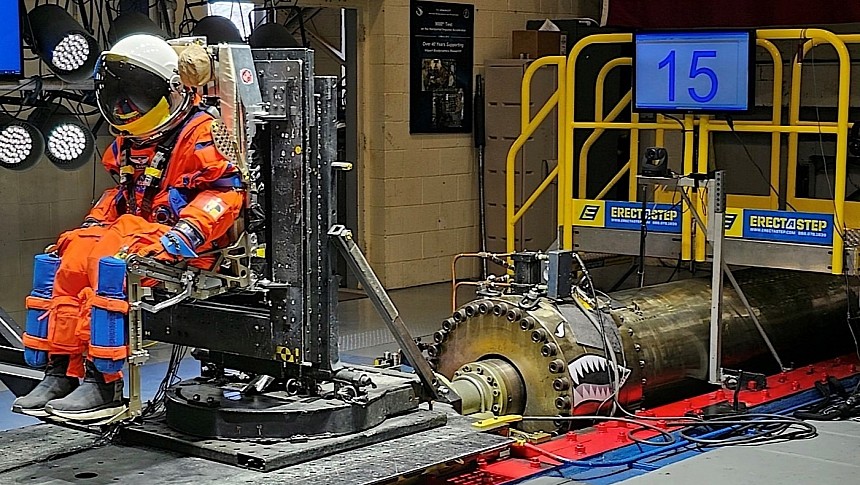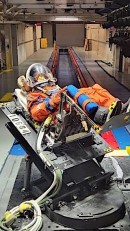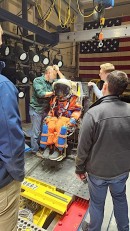They officially call it Commander Moonikin Campos, and to date it is the only humanoid-shaped thingy to have traveled to the Moon on board an Artemis mission. It did so because the commander is nothing more than a test dummy meant to validate gear and procedures for actual crewed missions to Earth's satellite.
The dummy got its name back in 2021, and it honors Arturo Campos, the man considered partially responsible for saving the Apollo 13 mission. He did so by devising a contingency plan meant to tackle the possibility of the service module oxygen tank failing – which is exactly what happened during that mission back in 1970.
Campos flew on board the Artemis I mission dressed in a suit called the Orion Crew Survival System (OCSS) – the same one that will be worn by the actual astronauts during launch and re-entry, the most critical phases of the lunar missions.
The ride up there was meant as a means for NASA engineers to test everything that needed to be tested in light of the first crewed missions of the program. The dummy did its thing wonderfully, but work on it and the help and insight it can provide from that are far from over.
The dummy is presently at the Wright-Patterson Air Force Base in Ohio where it is subjected to acceleration tests. Engineers do this using a sled, as they try to figure out how restraint systems, the OCSS, and the seats the astronauts will be using will perform during the extreme acceleration of launch and landing.
Just to give you an idea of what the dummy has to go through just consider the hundreds of feet long sled over at Wright-Patterson is capable of accelerating the Campos dummy to 19 times the force of gravity.
What happens to the mannequin during these runs is recorded by high-speed cameras (1,000 frames per second). The images and findings of these tests are used, as per NASA, to improve the safety of suit, helmet, and seat for future Artemis missions, but also to help design them in such a way as to be more comfortable for astronauts.
Whatever lessons NASA learns from these tests on the Campos dummy will first be put to the test during the Artemis II mission. It is scheduled to depart in November of next year, taking four people on a trip around the Moon: Reid Wiseman, Victor Glover, Christina Hammock Koch, and Jeremy Hansen.
Although they will not actually land on the Moon, the four brave souls will travel during their ten-day mission to the farthest distance from Earth any human has reached: 6,400 miles (10,300 km) beyond the Moon and 230,000 miles (370,000 km) away from home.
Campos flew on board the Artemis I mission dressed in a suit called the Orion Crew Survival System (OCSS) – the same one that will be worn by the actual astronauts during launch and re-entry, the most critical phases of the lunar missions.
The ride up there was meant as a means for NASA engineers to test everything that needed to be tested in light of the first crewed missions of the program. The dummy did its thing wonderfully, but work on it and the help and insight it can provide from that are far from over.
The dummy is presently at the Wright-Patterson Air Force Base in Ohio where it is subjected to acceleration tests. Engineers do this using a sled, as they try to figure out how restraint systems, the OCSS, and the seats the astronauts will be using will perform during the extreme acceleration of launch and landing.
Just to give you an idea of what the dummy has to go through just consider the hundreds of feet long sled over at Wright-Patterson is capable of accelerating the Campos dummy to 19 times the force of gravity.
What happens to the mannequin during these runs is recorded by high-speed cameras (1,000 frames per second). The images and findings of these tests are used, as per NASA, to improve the safety of suit, helmet, and seat for future Artemis missions, but also to help design them in such a way as to be more comfortable for astronauts.
Whatever lessons NASA learns from these tests on the Campos dummy will first be put to the test during the Artemis II mission. It is scheduled to depart in November of next year, taking four people on a trip around the Moon: Reid Wiseman, Victor Glover, Christina Hammock Koch, and Jeremy Hansen.
Although they will not actually land on the Moon, the four brave souls will travel during their ten-day mission to the farthest distance from Earth any human has reached: 6,400 miles (10,300 km) beyond the Moon and 230,000 miles (370,000 km) away from home.






